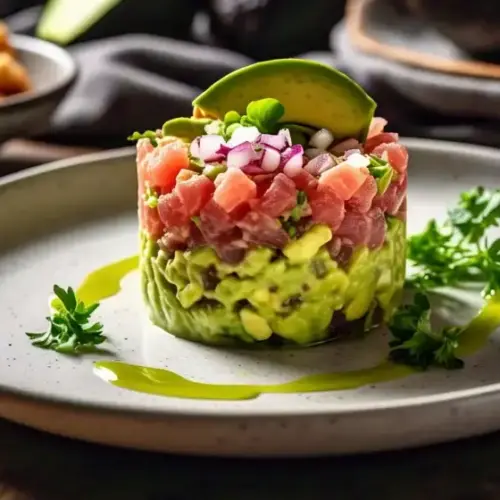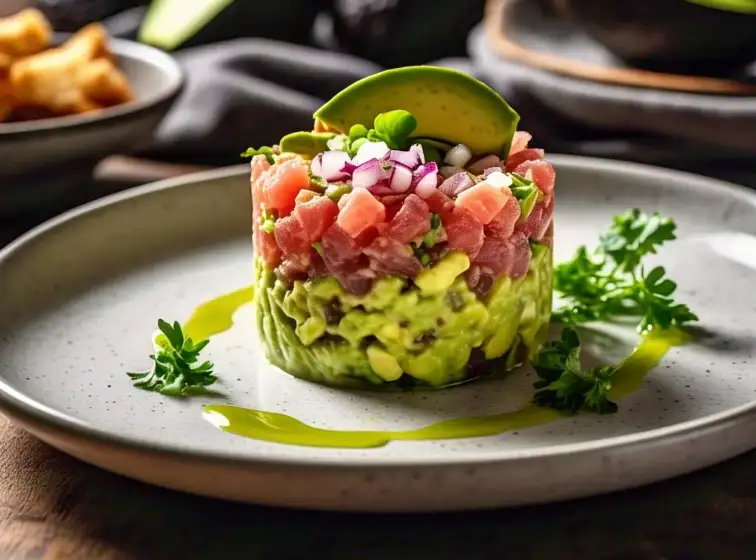Tartar de atún, or tuna tartare, is a delightful dish that combines simplicity, elegance, and bold flavors. This dish has become a staple in fine dining and casual gatherings, celebrated for its freshness and versatility. It highlights the natural taste of raw sashimi-grade tuna while incorporating various ingredients that enhance its flavor and texture.
TL;DR:
- Key Ingredients: Sashimi-grade tuna, lime/lemon juice, avocado, soy sauce, sesame oil.
- Presentation: Serve with tostadas, crackers, or in martini glasses.
- Tools: Use a sashimi knife and ring molds for precise preparation.
- Variations: Explore Japanese-inspired styles or substitute with salmon.
- Health Notes: High in protein, omega-3 fatty acids, and low carb.
Key Ingredients for Tartar de Atún
Sashimi-Grade Tuna: The Star of the Dish
The foundation of tartar de atún lies in the quality of the sashimi-grade tuna. Freshness is non-negotiable as the tuna is served raw, making its natural flavor and texture paramount. Always source tuna from reputable suppliers that follow safe handling practices, such as those with certifications like MSC (Marine Stewardship Council) or BAP (Best Aquaculture Practices). Reputable sources often include high-end grocery chains, specialty fish markets, or online retailers like Fulton Fish Market and Catalina Offshore Products.
- Choose deep red tuna with a firm texture.
- Avoid fish with an overpowering smell or dull color.
- Store the tuna properly in a chilled environment to maintain freshness.
- Dice the tuna evenly using a sharp sashimi knife for precision.
Lime or Lemon Juice: The Essential Acid
Citrus juice is an essential ingredient that brings brightness to the dish. The acidity in the juice interacts with the proteins on the surface of the raw tuna, causing them to denature slightly, similar to the initial stages of cooking. This process enhances the flavor without compromising the tuna’s natural texture and delicate taste.
- Freshly squeezed juice ensures optimal flavor.
- Lime juice is often preferred for its sharper acidity.
- Use the juice sparingly to avoid overpowering the delicate tuna.
Avocado: The Creamy Complement
Avocado adds a creamy texture that pairs wonderfully with the silky smoothness of the tuna. Its mild flavor balances the tart citrus and the umami components of the dish.
- Dice avocado into small, even cubes for consistency.
- Opt for ripe avocados that are firm yet slightly soft to the touch.
- Gently toss the avocado with the tuna to maintain its shape.
Soy Sauce and Sesame Oil: Umami Enhancers
Soy sauce and sesame oil introduce an umami depth that elevates the dish. These ingredients are often used in Japanese-inspired variations. For soy sauce, brands like Kikkoman or Yamasa provide a balance of saltiness and umami, while Lee Kum Kee or Pure Sesame Oil are excellent choices for a robust, nutty flavor. Experimenting with these can refine and personalize the dish to your taste.
- Add soy sauce in small quantities to avoid oversalting.
- A few drops of sesame oil can provide a nutty undertone.
- Consider adding a pinch of chili flakes or a splash of sriracha for a hint of spice.
Serving and Presentation
Tostadas and Crackers: The Perfect Base
Serving tartar de atún on tostadas or crackers provides a crunchy contrast to the soft texture of the tuna. This combination creates a balanced bite that’s both satisfying and flavorful.
- Use small, crispy tostadas for individual servings.
- Plain or lightly salted crackers work best to avoid overpowering the tartare.
- Arrange the toppings evenly to ensure each bite has all the flavors.

Recipe: Tartar de Atún Rojo con Aguacate
Equipment
- Professional food ring (7 cm diameter, or slightly larger)
- Small and medium-sized mixing bowls
- Sharp Santoku or chef’s knife
Ingredients
- For the Tuna Mixture:
- 350 grams of tuna previously frozen and thawed
- 3 tablespoons soy sauce
- 1 teaspoon wasabi optional, adjust to taste
- ½ teaspoon grated fresh ginger
- 1 tablespoon extra virgin olive oil
- 1 tablespoon sesame oil optional for added flavor
- 2 tablespoons red onion finely diced
- 1 tablespoon chopped parsley
- Salt and pepper to taste
- For the Avocado Layer:
- 2 avocados ripe but firm, diced
- 1 lime juice to prevent oxidation
- Salt to taste
- 1 firm tomato optional, finely diced
- Garnishes:
- Sesame seeds to sprinkle on top
- Capers optional
- Wasabi cream optional
- Fresh greens to decorate the plate
- Crackers or toasted bread for serving
Instructions
Prepare the Tuna:
- Dice the tuna into small cubes (less than 1 cm).
- In a bowl, mix the soy sauce, wasabi, grated ginger, sesame oil, and olive oil. Add the diced onion and parsley.
- Combine the tuna with the mixture, ensuring it is well coated. Cover and let it marinate in the refrigerator for at least 30 minutes, or ideally overnight for a more intense flavor.
Prepare the Avocado:
- Dice the avocados and mix with lime juice, olive oil, and a pinch of salt. (Optional: Add the diced tomato for additional texture and flavor.)
Assemble the Tartar:
- Place the food ring on a serving plate.
- Fill the bottom half of the ring with the avocado mixture. Press gently with a spoon to compact it.
- Add the marinated tuna on top of the avocado layer, pressing slightly to ensure it holds its shape.
- Carefully remove the ring.
Decorate and Serve:
- Sprinkle sesame seeds and capers on top of the tartar for garnish.
- Add a dollop of wasabi cream on the plate if desired.
- Serve with crackers or toasted bread.
Tips for the Best Results
- Use Frozen Tuna: Always freeze fresh tuna for at least 72 hours to eliminate any risk of parasites.
- Adjust Seasoning: Soy sauce is naturally salty, so adjust additional salt accordingly.
- Make Ahead: The marinated tuna can be prepared a day in advance for a richer flavor. However, assemble the tartar just before serving to maintain freshness.
- Customize: Experiment with added ingredients such as mango, pomegranate, or finely diced cucumber for a unique twist.
Notes
Garnishes: Aesthetic Enhancements
Garnishing the dish adds a layer of visual appeal. Popular choices include microgreens and nori (seaweed), which also contribute subtle flavors.
- Sprinkle finely chopped herbs like cilantro for freshness.
- Use small strips of nori for a touch of umami and crunch.
- Add edible flowers for an upscale touch.
Creative Plating Options
Presentation plays a key role in making tartar de atún visually appealing. Trendy plating options, such as serving in martini glasses, elevate the dish’s elegance.
- Use ring molds to shape the tartare neatly.
- Place the molded tartare on a chilled plate to preserve freshness.
- For a more modern look, drizzle sauce around the tartare instead of over it.
Culinary Variations and Inspirations
Japanese-Inspired Tuna Tartare
Incorporating Asian flavors adds a new dimension to tartar de atún. Ingredients like miso, wasabi, and pickled ginger provide bold and exciting twists.
- Mix a teaspoon of white miso paste into the dressing for added umami.
- Serve with a small dollop of wasabi for a spicy kick.
- Garnish with thinly sliced pickled ginger for a tangy contrast.
Salmon Tartare: A Close Cousin
While salmon tartare diverges from the traditional tuna-based dish, it offers a rich, buttery flavor that’s equally delicious.
- Substitute sashimi-grade salmon for tuna.
- Pair with the same citrus and avocado components.
- Add capers and shallots for a classic tartare touch.
Sashimi Knife: Precision Matters
A sharp sashimi knife is crucial for achieving clean, even cuts of tuna. Precision dicing ensures a consistent texture and enhances the overall experience.
- Keep the knife sharp to avoid tearing the fish.
- Clean the blade between cuts to maintain hygiene and precision.
- Practice proper knife skills to dice the tuna uniformly.
Ring Molds: Shaping Perfection
Using ring molds helps achieve a neat and professional presentation. These tools are particularly useful for shaping tartar de atún into uniform portions.
- Place the ring mold on a chilled plate before adding the tartare.
- Gently press the mixture into the mold without compacting it too tightly.
- Remove the mold carefully to retain the shape.
Health and Sustainability Considerations
Nutritional Benefits of Tuna Tartare
Tartar de atún is not only delicious but also packed with health benefits. It’s a nutrient-dense dish that fits well into a balanced diet.
- High in lean protein, supporting muscle growth and repair.
- Rich in omega-3 fatty acids, promoting heart and brain health.
- Low in carbohydrates, making it suitable for low-carb diets.
Sustainable Tuna Sourcing
Ensuring the tuna is responsibly sourced is critical for sustainability and ethical preparation.
- Look for tuna labeled as “MSC Certified” or “Dolphin Safe.”
- Avoid overfished species such as bluefin tuna.
- Support local fisheries that practice sustainable methods.
Closing Thoughts
Tartar de atún is a dish that seamlessly blends simplicity, elegance, and bold flavors. Its versatility allows for endless variations, making it a favorite among chefs and home cooks alike. Whether served as an appetizer or the star of a meal, this dish never fails to impress. By focusing on fresh, high-quality ingredients and thoughtful preparation, you can create a tartar de atún that’s both delicious and visually stunning.

